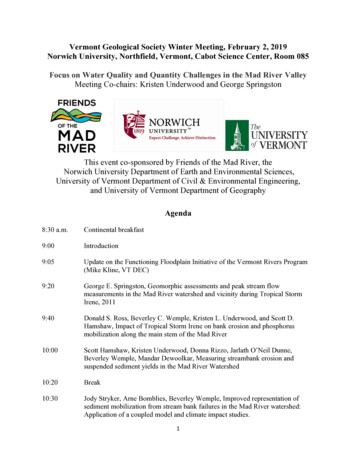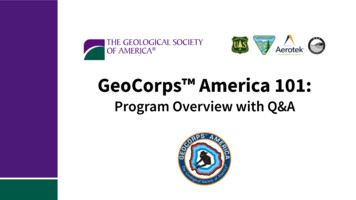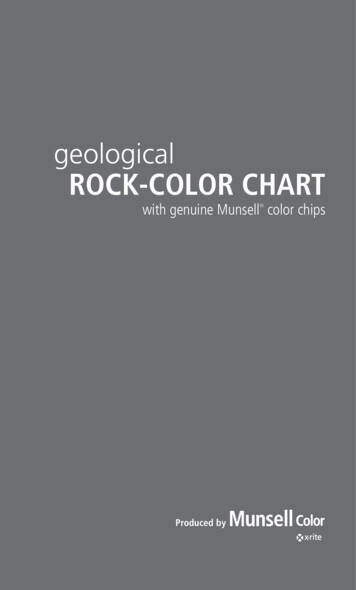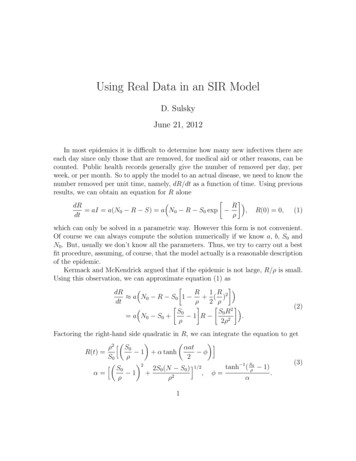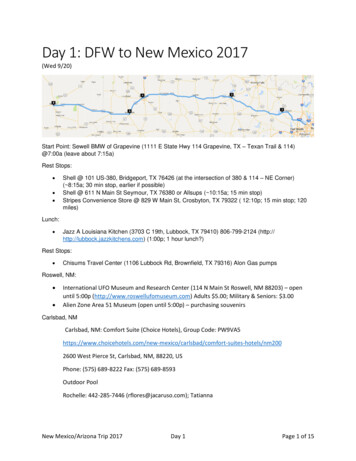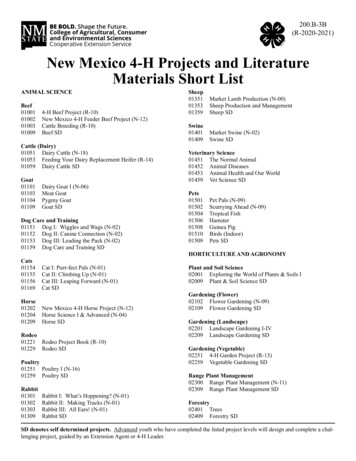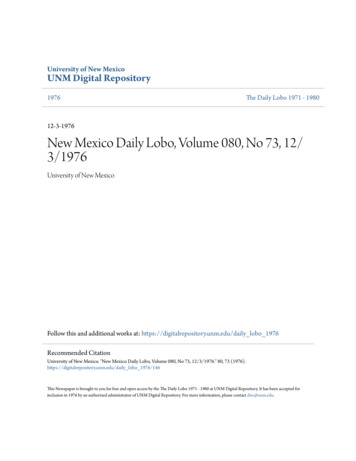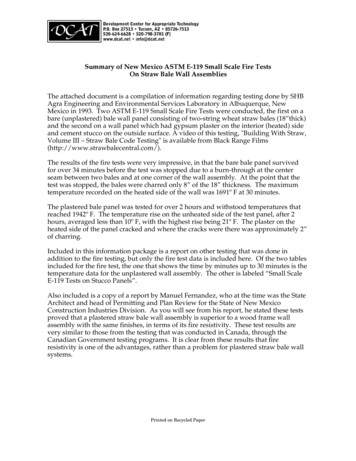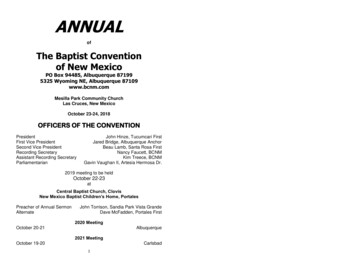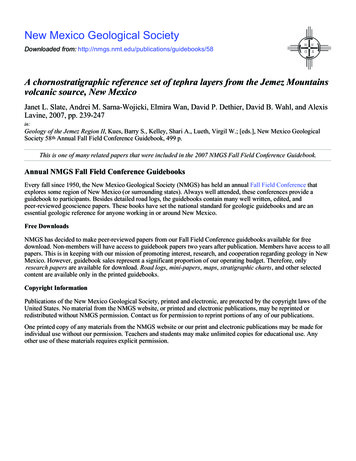
Transcription
New Mexico Geological SocietyDownloaded from: http://nmgs.nmt.edu/publications/guidebooks/58A chornostratigraphic reference set of tephra layers from the Jemez Mountainsvolcanic source, New MexicoJanet L. Slate, Andrei M. Sarna-Wojicki, Elmira Wan, David P. Dethier, David B. Wahl, and AlexisLavine, 2007, pp. 239-247in:Geology of the Jemez Region II, Kues, Barry S., Kelley, Shari A., Lueth, Virgil W.; [eds.], New Mexico GeologicalSociety 58th Annual Fall Field Conference Guidebook, 499 p.This is one of many related papers that were included in the 2007 NMGS Fall Field Conference Guidebook.Annual NMGS Fall Field Conference GuidebooksEvery fall since 1950, the New Mexico Geological Society (NMGS) has held an annual Fall Field Conference thatexplores some region of New Mexico (or surrounding states). Always well attended, these conferences provide aguidebook to participants. Besides detailed road logs, the guidebooks contain many well written, edited, andpeer-reviewed geoscience papers. These books have set the national standard for geologic guidebooks and are anessential geologic reference for anyone working in or around New Mexico.Free DownloadsNMGS has decided to make peer-reviewed papers from our Fall Field Conference guidebooks available for freedownload. Non-members will have access to guidebook papers two years after publication. Members have access to allpapers. This is in keeping with our mission of promoting interest, research, and cooperation regarding geology in NewMexico. However, guidebook sales represent a significant proportion of our operating budget. Therefore, onlyresearch papers are available for download. Road logs, mini-papers, maps, stratigraphic charts, and other selectedcontent are available only in the printed guidebooks.Copyright InformationPublications of the New Mexico Geological Society, printed and electronic, are protected by the copyright laws of theUnited States. No material from the NMGS website, or printed and electronic publications, may be reprinted orredistributed without NMGS permission. Contact us for permission to reprint portions of any of our publications.One printed copy of any materials from the NMGS website or our print and electronic publications may be made forindividual use without our permission. Teachers and students may make unlimited copies for educational use. Anyother use of these materials requires explicit permission.
This page is intentionally left blank to maintain order of facing pages.
NewMexico Geological Society Guidebook, 58th FieldConference, Geologythe JemezMountainsLAYERSRegion II, 2007, p. 239-247.A CHRONOSTRATIGRAPHICREFERENCESETof OFTEPHRA239A CHRONOSTRATIGRAPHIC REFERENCE SET OF TEPHRALAYERS FROM THE JEMEZ MOUNTAINS VOLCANIC SOURCE,NEW MEXICOJANET L. SLATE1, ANDREI M. SARNA-WOJCICKI2, ELMIRA WAN2, DAVID P. DETHIER3,DAVID B. WAHL2, AND ALEXIS LAVINE4U.S. Geological Survey, Box 25046, MS 980, Denver Federal Center, Denver, CO 80225 jslate@usgs.gov2U.S. Geological Survey, 345 Middlefield Rd., MS 975, Menlo Park, CA 940253Williams College, Geosciences Dept., Williamstown, MA 012674Geomatrix Consultants, Inc., 2101 Webster St., Suite 1200, Oakland, CA 946121ABSTRACT — Electron-microprobe analyses on volcanic glass separated from 65 pumice-fall and ash-flow tephra units ofthe Jemez Mountains, New Mexico, show that they are mainly rhyolites and dacites. From youngest to oldest, the units are:El Cajete Member of Valles Rhyolite ( 50-60 ka); Tshirege Member including basal Tsankawi Pumice Bed of the BandelierTuff (both 1.21-1.25 Ma); Cerro Toledo Rhyolite ( 1.22-1.59 Ma); Otowi Member including basal Guaje Pumice Bed of theBandelier Tuff (both 1.61-1.68 Ma); the informal San Diego Canyon ignimbrites ( 1.84-1.87 Ma); Puye Formation tephralayers ( 1.75 - 5.3 Ma); upper Keres Group, Peralta Tuff Member of the Bearhead Rhyolite ( 6.76-6.96 Ma); and lowerKeres Group, Paliza Canyon Formation – Canovas Canyon Rhyolite ( 7.4- 12.4 Ma). The Tshirege and Otowi Members ofthe Bandelier Tuff are difficult to distinguish from each other on the basis of electron-microprobe analysis of the volcanic glass;the Tshirege Member contains on average more Fe than the Otowi Member. The Cerro Toledo tephra layers are readily distinguishable from the overlying and underlying units of the Bandelier Tuff primarily by lower Fe and Ca contents. The San DiegoCanyon ignimbrites can be distinguished from all members of the overlying Bandelier Tuff on the basis of Fe and Ca. Tuffs inthe Puye Formation are dacitic rather than rhyolitic in composition, and their glasses contain significantly higher Fe, Ca, Mg,and Ti, and lower contents of Si, Na, and K. The Bearhead Rhyolite is highly evolved and can be readily distinguished fromthe younger units. We conclude that the Puye is entirely younger than the Bearhead Rhyolite and that its minimum age is 1.75Ma. The Paliza Canyon volcaniclastic rocks are chemically variable; they range in composition from dacite to dacitic andesiteand differ in chemical composition from the younger units.INTRODUCTIONWe analyzed a large set of tephra layers from the JemezMountains volcanic source area of north-central New Mexico(Fig. 1), to serve as a reference set for chronostratigraphic correlations to areas outside the Jemez Mountains. Tephra eruptedfrom the Jemez Mountains sources has been transported by airor by streams, and deposited in adjacent basins (for example, theEspañola and Albuquerque basins), forming stratigraphic markerbeds.Eruptive products of the Jemez Mountains volcanic field rangefrom mid-Miocene ( 15 Ma) to late Pleistocene and are relatedto extension along the Rio Grande rift and coincident intersection with the Jemez lineament (Gardner and Goff, 1984; Aldrichet al., 1986). These are formally assigned to the Keres Group inthe south ( 13 to 6 Ma), the Polvadera Group mainly in the north( 13 to 2 Ma), and the Tewa Group in the central and flankingparts of the mountains ( 2 Ma) (Bailey et al., 1969). Pre-Quaternary volcanism of basalt-andesite-dacite-rhyolite associationformed the constructional phase of the Jemez Mountains. Explosive rhyolitic volcanism during the Quaternary formed the Toledoand Valles calderas. Although studies of Jemez Mountains volcanism are numerous (e.g., Smith and Bailey, 1966; Bailey et al.,1969; Smith et al., 1970; Gardner and Goff, 1984; Self et al.,1988, 1991, 1996; Stix et al., 1988; Turbeville and Self, 1988;Turbeville et al., 1989; Spell et al., 1990, 1996a, b; Lavine etal., 1996; WoldeGabriel et al., 1996, 2001, 2006), little work hasbeen done to characterize the glass chemistry of the major tephralayers (e.g., Izett et al., 1972; Dunbar et al., 1996).We analyzed volcanic glass separated from 65 pumice-falland ash-flow tephra units of the major Jemez Mountains tephralayers, which span a time range from 12.4 Ma to 0.05 Ma.Many of these units have been dated directly by others, mostlyusing K-Ar and 40Ar/39Ar techniques; those undated are, in manycases, bracketed between dated tephra layers. Sample preparationand analytical methods by electron microprobe are as describedFIGURE 1. Shaded-relief image map showing location of tephra samples (white triangles) in the Jemez Mountains area, north-central NewMexico.
SLATE, SARNA-WOJCICKI, WAN, DETHIER, WAHL, & LAVINE240in Sarna-Wojcicki et al. (2005). In Table 1, we list the majorgroups of Jemez Mountains tephra layers analyzed in this studyin stratigraphic order and essentially concordant age (youngestto oldest).MAJOR JEMEZ MOUNTAINS TEPHRA LAYERSEl Cajete Member of Valles RhyoliteThe youngest eruptive products of the Jemez Mountains volcanic field consist of six intra-caldera members of the Valles Rhyolite (Bailey et al., 1969). The El Cajete Member of the VallesRhyolite (El Cajete series of Self et al., 1988) is a widespreadstratigraphic marker east, southeast, and south of the Vallescaldera. Comprising three units of which the Plinian eruptionproduced a dispersed pumice-fall deposit (about 1.3 km3), theEl Cajete has a homogeneous high-silica rhyolitic composition(Appendix 1). Ages for the El Cajete range from about 45 to 73ka based on electron spin resonance analyses of quartz phenocrysts (Toyoda et al., 1995), to about 48 to 63 ka based on thermoluminescence of soils buried by El Cajete pumice (Reneau etTABLE 1. The major groups of Jemez Mountains volcanic field tephralayers analyzed in this study listed in stratigraphic order and essentiallyconcordant age (youngest to oldest).UnitEl Cajete Member ofValles RhyoliteTshirege Member of theBandelier TuffBasal Tsankawi Pumice Bedof the Tshirege MemberDeposit Type(s)Pumice fallAge 50 – 60 ka1Ash flows 1.21 – 1.25 Ma2Cerro Toledo RhyolitePumice fall 1.22 – 1.59 Ma3Otowi Member of theBandelier TuffAsh flows 1.61 – 1.68 Ma2Basal Guaje Pumice Bed ofthe Otowi MemberPumice fallPumice fallAsh flows andpumicefallsPuye Formation tephra layers Pumice fallsSan Diego CanyonignimbritesUpper Keres Group:Peralta Tuff Member of theBearhead RhyoliteLower Keres Group:Paliza Canyon Formation –Canovas Canyon Rhyolite2Bandelier TuffThe pre-Valles Rhyolite part of the Tewa Group comprises thebulk of the tephra analyzed for this study and is subdivided intothe upper and lower members of the Bandelier Tuff (Tshirege andOtowi Members, respectively) and the intervening Cerro ToledoRhyolite. The upper and lower members of the Bandelier Tuff arefurther subdivided into basal pumice-fall units (Tsankawi PumiceBed of Tshirege and Guaje Pumice Bed of Otowi) and overlyingash-flow units (Table 1).Major Pleistocene caldera-forming eruptions of the BandelierTuff totaling 650 km3 (Self et al., 1996) spread tephra across awide area. Identified as far as 700 km away in northwestern Texas(Izett et al., 1972), up to 10 cm of primary airfall in Socorro about300 km south (Dunbar et al., 1996), and up to 3 m-thick layers20 km from the vent (Self et al., 1996), the resultant 22 km-wideValles caldera rivals the silicic volcanic centers of Yellowstone,WY, and Long Valley, CA.Our studies indicate that the Tshirege and Otowi Members ofthe Bandelier Tuff are difficult to distinguish from each other onthe basis of electron-microprobe analysis of the volcanic glass(Fig. 2). The Tshirege Member contains on average more Fe thanthe Otowi Member. The Cerro Toledo tephra layers are readilydistinguishable from the overlying and underlying units of theBandelier Tuff on the basis of glass composition, primarily bylower Fe and slightly higher Ca contents (Fig. 2).Upper Bandelier Tuff—Tshirege Member and BasalTsankawi Pumice Bed 1.84 – 1.87 Ma4 1.75 – 5.3 Ma5Pyroclastic 6.76 – 6.96 Ma6breccias, ashflows, and pumicefalls 7.4 – 12.4 Ma7Ash flows andpumice fallsToyoda et al. (1995), Wolff and Gardner (1995), Reneau et al. (1996)Spell et al. (1990), Phillips et al. (2006)3Spell et al. (1996a, b)4Smith et al. (2001)5Dethier (2003), WoldeGabriel et al. (2001, 2006)6McIntosh and Quade (1995), Smith et al. (2001)7Goff et al. (1990), Lavine et al. (1996), WoldeGabriel et al. (2006)1al., 1996), to about 60 ka based on 14C of associated carbonizedlogs (Wolff and Gardner, 1995), to as much as 130 to 170 kabased on fission-track and U-Th disequilibrium (Self et al., 1988,1991) and even older K-Ar and 40Ar/39Ar ages. We report the ageas a range from 50 to 60 ka (Table 1) accepting that the olderages were contaminated by xenocrysts or excess Ar (Reneau etal., 1996). El Cajete eruptions came after a 460-ky period ofquiescence (Wolff and Gardner, 1995).The Tshirege Member comprises the upper of the two members of the Bandelier Tuff and is associated with the collapse ofthe Valles caldera (Self et al., 1996). The Tsankawi is the basalpumice-fall deposit (about 15 km3) of the Tshirege Member, asuccession of cliff-forming welded ash flows. 40Ar/39Ar datingestablishes the age of this coupled unit at 1.21 to 1.25 Ma (Spellet al., 1990; Phillips et al., 2006). Although the dominant winddirection at the time of eruption determined the distribution of theairfall tephra, the ignimbrite was widely distributed around thevent; the maximum measured thickness of the Tshirege Memberis 250 m (Self et al., 1996).Cerro Toledo RhyoliteBetween the upper and lower members of the Bandelier Tuff,the Cerro Toledo Rhyolite comprises a series of rhyolite domes,lava flows, and associated ash-fall deposits (Stix et al., 1988).
A CHRONOSTRATIGRAPHIC REFERENCE SET OF TEPHRA LAYERS241the lower member of the Bandelier Tuff in the southwestern partof the Jemez Mountains. These ignimbrite units have identical40Ar/39Ar dates of 1.84 to 1.87 Ma (Smith et al., 2001); earlierreported K-Ar ages may have been contaminated by xenocrysts(Spell et al., 1990). Virtually indistinguishable by major-elementchemistry, the San Diego Canyon ignimbrites are high-silicarhyolites in composition (SiO2 75 wt. %) and have low abundances of CaO, MgO, and MnO (Spell et al., 1990; Appendix1). Although chemically similar to the members of the BandelierTuff, the ash flows and fall pumice of the San Diego Canyonignimbrites can be distinguished from all members of the overlying Bandelier Tuff on the basis of lower Fe (Fig. 2).Puye Formation tephra layersFIGURE 2. Weight percent of CaO versus FeO in glass shards of silicicJemez Mountains tephra. Each point represents an average of 15-20analyses.Erupted within about 100 ky of the lower member of the Bandelier Tuff from along the caldera margin, these eruptions aresmall in volume compared to those of the upper and lower members of the Bandelier Tuff. Cerro Toledo Rhyolite eruptions continued for about 400 ky; the final event is about the same ageas the upper member of the Bandelier Tuff (Spell et al., 1990,1996a, b). Dated pumice-fall units indicate eruptive activity at 1.59, 1.54, 1.48, 1.37, and 1.22 Ma (Spell et al., 1996b). Wellexposed in Los Alamos Canyon, the Cerro Toledo Rhyolite fillsthe Toledo embayment as mapped by Gardner and Goff (1996).Stix et al. (1988) described the high-silica rhyolite geochemistryand compositional zonation of the Cerro Toledo Rhyolite; Spellet al. (1996a, b) argued against progressive evolution of a single,closed-system magma chamber.Lower Bandelier Tuff—Otowi Member and basal GuajePumice BedThe Otowi Member comprises the lower of the two membersof the Bandelier Tuff, the eruption of which resulted in the Toledocaldera. The Guaje is the basal pumice-fall deposit (about 20 km3)of the Otowi Member, a massive pumiceous tuff breccia of ashflow origin. This coupled unit is dated at 1.61 Ma by 40Ar/39Ar(Spell et al., 1990); more recent 40Ar/39Ar dating of welded ignimbrite produced a pooled age of 1.68 Ma (Phillips et al., 2006).Widely buried by the upper member, the maximum thickness ofthe Otowi Member is 180 m (Self et al., 1996).San Diego Canyon ignimbritesThe earliest phases of rhyolitic explosive volcanism from theJemez Mountains volcanic field, the San Diego Canyon ignimbrites (lower “A” and upper “B”; Turbeville and Self, 1988; Turbeville et al., 1989) are well exposed (up to 80 m thick) beneathFlanking the east side of the northern Jemez Mountains, thePuye Formation is a volcaniclastic alluvial-fan sequence thatdeveloped in response to the growth and erosion of dacite domes(Waresback, 1986; Waresback and Turbeville, 1990). The PuyeFormation comprises 15 km3 of coarse-grained volcaniclasticsediments derived from the northeastern Jemez highlands from 5 to 1.8 Ma (Waresback and Turbeville, 1990; WoldeGabriel etal., 2001). Well exposed in Rendija and Guaje Canyons, preservation of the Puye and intervening tephra layers was enhanced bynearly continuous aggradation of the clastic deposits in the spacecreated by rifting along the Rio Grande and subsequent coverageby the lower Bandelier Tuff (Dethier, 2003).Tuffs in the Puye Formation, other than the fall pumice of theSan Diego Canyon ignimbrite (“B”) near the top, are chemicallyquite different from the Tewa Group and San Diego Canyon units(Fig. 3). The Puye tuffs are dacitic rather than rhyolitic in composition, and their glasses contain significantly higher Fe2O3, CaO,MgO, and TiO2, with lower contents of SiO2, Na2O, and K2O(Appendix 1). Although we are able to correlate tuffs in the PuyeFormation among sites and to sedimentary sections within theEspañola basin, numerical age control on tephra layers is sparse.WoldeGabriel et al. (2001, 2006) reported an 40Ar/39Ar age of 5.3Ma for a vitric ash near the base.Keres GroupThe Keres Group (Bailey el al., 1969) consists of a lower(older) subgroup and an upper (younger) subgroup. The PalizaCanyon Formation basalts, andesites and dacites, and the CanovasCanyon Rhyolite form the lower Keres Group; the upper KeresGroup comprises the Bearhead Rhyolite, which includes the Peralta Tuff Member (Lavine et al., 1996). 40Ar/39Ar ages reportedfor the Canovas Canyon Rhyolite and Paliza Canyon Formationrange from 9 to 12.4 Ma (Lavine et al., 1996; WoldeGabriel etal., 2006). Accepted 40Ar/39Ar ages for the Peralta Tuff Memberof the Bearhead Rhyolite range from 6.76 to 6.96 Ma (McIntoshand Quade, 1995; Smith et al., 2001).Tephra of the upper Keres Group, the Bearhead Rhyolite, ishighly evolved, and can be readily distinguished from the youngerunits mentioned above on the basis of electron-microprobe glasschemistry (Fig. 3). Because no Bearhead Rhyolite tephra has
242SLATE, SARNA-WOJCICKI, WAN, DETHIER, WAHL, & LAVINEbeen found in the Puye Formation, we conclude that the Puye isentirely younger than the Bearhead Rhyolite, 7 Ma, and that itsminimum age is equal to or younger than 1.85 Ma (the age ofthe San Diego Canyon ignimbrite) at the top.Tephra of the lower Keres Group, the Paliza Canyon Formation volcaniclastic rocks, are chemically quite variable (Fig.3; Appendix 1), ranging in composition from dacite to daciticandesite. These tephra layers also differ in chemical compositionfrom the younger units.CORRELATION OF JEMEZ MOUNTAINS TEPHRA TOSITES BEYOND THE SOURCE AREATephra layers correlative with the Bandelier Tuff, Cerro ToledoRhyolite, San Diego Canyon ignimbrites, and the Bearhead Rhyolite have been identified in sedimentary sections beyond theJemez Mountains. Specifically, reworked ash and pumice of theTshirege and Otowi Members of the Bandelier Tuff and the CerroToledo Rhyolite have been found at various locations in the Albuquerque basin (Connell, 2006), and in Quaternary alluvium overlying the Puye Formation. Ash of the Tsankawi Pumice Bed (basalairfall of the Tshirege Member) is found as far to the northwestas central Utah (Sarna-Wojcicki, unpubl. data), and ash of theGuaje Pumice Bed, basal airfall of the Otowi Member, is foundeast as far as central Texas (Izett et al., 1972). We correlate theSan Diego Canyon ignimbrite (“B”) to the top of the Puye Formation. The tephra layer in the upper Puye is a fall pumice, possibly representing an early Plinian eruptive phase of the San DiegoCanyon ignimbrite or perhaps related to older, buried domes thatdate to 2.3 Ma (Dethier, 2003). We have not yet identified tephracorrelative with the lower Keres Group Paliza Canyon Formationtephra outside the Jemez Mountains.CONCLUSION, USES OF THESE DATA,AND FURTHER WORKData obtained on these tephra layers are integrated with isotopic, magnetostratigraphic, and other data to provide a spatial andtemporal framework for studies of surface and subsurface chronostratigraphy, structure, and hydrogeology in the Española andAlbuquerque basins. The correlations and age control presentedhere, in combination with geologic mapping, provide a basic spatial and temporal framework for the Jemez Mountains–Españolabasin–Albuquerque basin study region. This region is ideal fordeveloping a high-resolution Neogene chronostratigraphy becausethe Jemez Mountains have been a source of silicic volcanism forthe past 13 Ma (Self et al., 1996). Tephra from these eruptions hasbeen transported by wind and water throughout this region, and iswell preserved within the depositional basins. These tephra layersprovide time and space horizons
3Williams College, Geosciences Dept., Williamstown, MA 01267 4 Geomatrix Consultants, Inc., 2101 Webster St., Suite 1200, Oakland, CA 94612 A BSTRACT — Electron-microprobe analyses on volcanic glass
